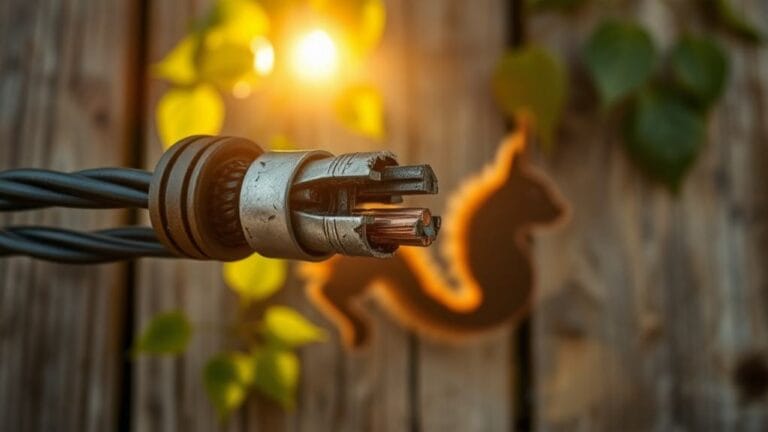If you're hearing scratching in your walls, you've got a squirrel problem that needs immediate action. These bushy-tailed invaders can squeeze through holes as small as 1½ inches and love making your walls their cozy winter retreat. But don't ignore those sounds – squirrels chew electrical wires (hello, fire hazard), spread diseases through their droppings, and can cause thousands in structural damage. Your first steps: locate their entry points near roof vents or fascia boards, check for baby squirrels (especially during nesting seasons), and consider installing one-way doors for safe removal. The longer you wait, the more damage these unwanted roommates will cause.
Understanding Wall Dwelling Squirrels
Table of Contents
Inside your walls, squirrels seek more than just a temporary hideout – they're looking for a permanent home that offers warmth, darkness, and protection.
If you're hearing mysterious scratching sounds during daylight hours, congratulations! You've got some furry squatters making themselves at home. While single-animal traps can help remove individual squirrels, larger infestations may require multi-catch solutions.
These unwanted tenants aren't just noisy neighbors. They're potential troublemakers who can slip through holes as tiny as three inches (yes, really).
And trust me – they're not paying rent for the damage they'll cause to your electrical wiring.
Signs of a squirrel infestation:
- Scratching and scurrying noises (especially during the day)
- Unexplained holes around your home's exterior
- Droppings and that lovely musky odor
The health risks from these wall-dwelling guests are no joke. From disease-carrying droppings to flea infestations, you'll want to contact professional wildlife removal experts ASAP.
Signs of Squirrel Activity

While identifying wall-dwelling squirrels can be tricky, knowing the telltale signs of their activity will help you spot an infestation early.
You'll want to watch for scratching and scrabbling noises, especially during daylight hours when these furry troublemakers are most active.
Nesting materials like twigs, leaves, and moss often accumulate near entry points as squirrels build their nests.
Look out for these dead giveaways of a squirrel infestation:
- Droppings that look like rat poop (minus the pointy ends)
- Gnawing sounds that mean they're redecorating your walls
- Chewed-up entry points near your roof or vents
- Mysterious stains or funky smells from their nesting habits
*Pro Tip: If you're hearing noises and spot even one of these signs, don't wait around hoping they'll leave on their own. Get professional assistance before these unwanted tenants cause serious damage to your home's wiring or insulation.*
Health and Property Risks

A squirrel infestation can put your family's health and property at serious risk.
Let's be real – those cute little critters aren't so adorable when they're spreading diseases through their droppings and urine. Regular inspections and proper insulation protection are essential since squirrels commonly tear up attic materials for nesting.
You're dealing with serious health risks like Salmonellosis and Leptospirosis. Fun times, right?
But wait, there's more! Your furry houseguests love to:
- Chew through electrical wires (hello, potential house fire!)
- Spread fleas and ticks to your pets
- Create respiratory issues with their waste
- Leave you lovely "presents" that affect your indoor air quality
Pro Tip: Don't wait for that lovely decomposing smell to kick in before calling squirrel removal services.
The longer you wait to prevent squirrel access and address structural damage, the more dangerous your situation becomes.
Trust me, your lungs (and wallet) will thank you later.
Locating Entry Points

Entry-point detection marks your first essential step in squirrel removal success. These nimble pests can squeeze through holes as small as 1½ inches – yeah, they're basically furry contortionists.
You'll want to watch for scratching and scurrying sounds that indicate squirrel activity behind your walls. You'll need to inspect your home thoroughly to find how they gain access.
Pro Tip: Grab a flashlight and channel your inner detective!
Here's where those pesky squirrels commonly break in:
- Roof vents and ridge caps (their favorite VIP entrance)
- Construction gaps between roof sheeting and fascia boards
- Damaged areas near gutters where they've pushed up shingles
- Gable vents and other roof openings
Look for telltale signs like chew marks and claw scratches around potential entry points.
If you're not comfortable playing wildlife detective, don't hesitate to call wildlife removal professionals. They'll help seal potential entry points properly.
Baby Squirrel Considerations

During squirrel removal, dealing with baby squirrels requires special attention and timing.
You'll need to watch for peak nesting seasons (January-May and August-October) when mothers are likely to have young ones in your walls. Understanding their nesting and shelter habits helps identify where babies may be hidden.
Here's what you need to know:
- Listen for soft peeping sounds – that's your sign there are babies present
- Look for puffy, mounded nests near entry points
- Don't disturb the nest (seriously, just don't)
Pro Tip: If you hear tiny squeaks in your walls, don't play hero – call a professional wildlife control service immediately.
Your best bet is getting help with squirrel removal from experts who know how to handle these situations.
A removal company will safely relocate the family and seal entry points properly.
Trust us – baby squirrels aren't a DIY project you want to tackle.
Safe Removal Methods

Three proven methods exist for safely removing squirrels from your walls without causing harm to the animals.
Let's face it – those furry acrobats need to go, but you don't want a guilt trip on your conscience.
- Install a one-way door at their main entry point (yes, they're predictable enough to use the same route)
- Set up humane traps near known pathways (check them frequently – nobody likes a hangry squirrel)
- Call professional wildlife control services if you've got babies or injured squirrels in there
- Monitor and seal ALL entry points once they're gone (or they'll invite their cousins over)
Pro tip: Don't try DIY solutions like smoke or noise makers. You'll just make them angry, and nobody wins when you've got angry squirrels in your walls.
Focus on proven squirrel removal methods that actually work and keep everyone safe.
Sealing and Prevention Strategies

Homeowners face a critical challenge when it comes to keeping squirrels out for good – proper sealing and prevention.
You'll need to get serious about squirrel removal by conducting a thorough inspection of your home's exterior. Those fuzzy troublemakers can squeeze through holes barely bigger than a golf ball (yeah, really – just 1½ inches).
Here's your gameplan:
- Seal entry points with galvanized steel or heavy wire – no cheap fixes!
- Trim those tree branches hanging over your roof (they're basically squirrel highways)
- Check vents, chimneys, and pipe entrances religiously
- Install one-way doors where needed
Pro Tip: Don't attract squirrels by leaving food and water sources around your yard. You're not running a squirrel bed & breakfast here.
Remember to inspect your sealing work regularly. Those persistent critters never stop looking for ways in.
Damage Assessment and Repair

Every squirrel infestation leaves behind a trail of destruction that needs careful assessment and repair.
You'll need to thoroughly inspect your space for these pesky rodents' handiwork and document everything – trust me, your insurance company will want proof!
- Check wiring and electrical systems for gnaw marks (because apparently, squirrels think they're electricians)
- Look for contaminated insulation that's been used as nesting materials
- Inspect walls and ceilings for entry points and structural damage
- Document all damage with photos before starting repairs
Once you've completed your damage assessment, it's time to get serious about repairs.
Remove any contaminated materials, patch those entry points with galvanized steel, and restore your insulation.
Don't cut corners here – proper repairs now will save you from future unwanted roommates!
*Pro Tip: Always verify all squirrels are gone before sealing everything up!*
Professional Wildlife Control Options

While DIY repairs can address some squirrel problems, tackling a serious infestation often requires professional expertise. Companies like Green Valley Wildlife Solutions specialize in professional wildlife control and know exactly what they're dealing with – unlike your internet research at 3 AM while listening to scratching in your walls.
These experts bring serious advantages to the table:
- They'll conduct thorough assessments to find every sneaky entry point.
- They use humane removal methods like one-way doors (yes, it's basically a squirrel exit-only strategy).
- They'll actually seal those spots properly – no more squirrel superhighways into your home.
You'll get peace of mind knowing they're handling any health hazards from droppings or urine.
Plus, many offer service guarantees.
Let's face it – when there's a furry family setting up shop in your walls, it's time to call the pros.
Frequently Asked Questions
How to Get Rid of a Squirrel in the Walls?
Listen for scratching to locate the squirrel, check for entry points with a flashlight, create a temporary exit hole, install a one-way door, and seal all openings once it's gone. Call professionals if needed.
What to Do if You Hear a Squirrel in the Wall?
When you hear those thunderous scratches in your wall, confirm it's during daytime hours, inspect for entry points with a flashlight, document damage, and don't hesitate to call professional wildlife removal if you're unsure.
How Long Can a Squirrel Live Trapped in a Wall?
You'll find that a trapped squirrel can survive for 3-4 days without food, but it's likely to die within a week due to dehydration and stress. Don't wait – quick removal is essential.
How Much Does It Cost to Get a Squirrel Out of Your Wall?
You'll typically pay between $200-$600 for professional squirrel removal from your wall. If you need emergency services or repairs, costs can climb to $800+, with additional charges for inspection and sealing entry points.
Last Word
Getting rid of wall-dwelling squirrels isn't like shooing away a party crasher – it's a serious mission that needs your full attention. You've now got the tools and knowledge to handle these uninvited tenants. Don't wait until they've turned your walls into their personal condo complex. Take action today, seal those entry points, and show those bushy-tailed intruders who's boss. If you're not confident, call the pros – it's cheaper than replacing chewed wiring.








